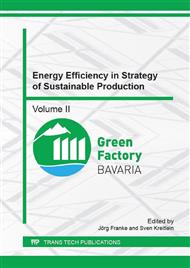p.188
p.195
p.201
p.209
p.217
p.224
p.231
p.238
p.244
Quantifying Powder Losses and Analyzing Powder Conditions in order to Determine Material Efficiency in Laser Beam Melting
Abstract:
Laser Beam Melting (LBM) is an additive manufacturing process, which is increasingly applied for the production of end use parts. One advantage of this powder bed fusion technology lies in the high material efficiency in comparison with subtractive manufacturing processes (i. e. milling, lathing). However, only few experimental studies have been conducted on the material efficiency of LBM. For the accurate evaluation of the LBM material efficiency, empirical values for powder losses are required. Furthermore, a lack of terminology for waste types and powder conditions in the context of LBM impedes communication and research on the topic. The presented paper aims to increase the understanding of material efficiency and powder conditions in Laser Beam Melting. A quantitative analysis of waste types is presented for different LBM application scenarios. This sets a basis for the ecological evaluation and comparison with conventional manufacturing processes. In order to achieve the aim, a terminology is introduced for waste types and powder conditions in the context of powder bed-based additive processes. Therefore, considerations regarding powder quality are taken into account. For the quantification of powder losses, the experimental setup and measurement results are described. Furthermore, loss types and their significance are analyzed and discussed.
Info:
Periodical:
Pages:
231-237
Citation:
Online since:
November 2016
Price:
Сopyright:
© 2017 Trans Tech Publications Ltd. All Rights Reserved
Share:
Citation:


